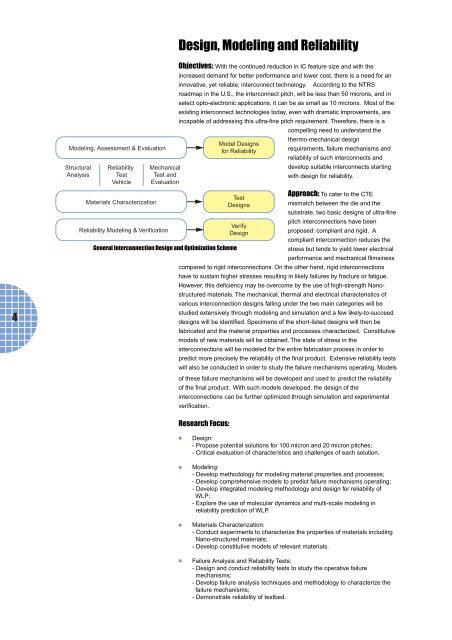Packaging Nano Wafer Level - National University of Singapore
Packaging Nano Wafer Level - National University of Singapore
Packaging Nano Wafer Level - National University of Singapore
You also want an ePaper? Increase the reach of your titles
YUMPU automatically turns print PDFs into web optimized ePapers that Google loves.
Design, Modeling and ReliabilityModeling, Assessment & EvaluationStructuralAnalysisReliabilityTestVehicleMechanicalTest andEvaluationObjectives: With the continued reduction in IC feature size and with theincreased demand for better performance and lower cost, there is a need for aninnovative, yet reliable, interconnect technology. According to the NTRSroadmap in the U.S., the interconnect pitch, will be less than 50 microns, and inselect opto-electronic applications, it can be as small as 10 microns. Most <strong>of</strong> theexisting interconnect technologies today, even with dramatic improvements, areincapable <strong>of</strong> addressing this ultra-fine pitch requirement. Therefore, there is acompelling need to understand theModel Designsfor Reliabilitythermo-mechanical designrequirements, failure mechanisms andreliability <strong>of</strong> such interconnects anddevelop suitable interconnects startingwith design for reliability.4Materials CharacterizationReliability Modeling & VerificationGeneral Interconnection Design and Optimization SchemeTestDesignsVerifyDesignApproach: To cater to the CTEmismatch between the die and thesubstrate, two basic designs <strong>of</strong> ultra-finepitch interconnections have beenproposed: compliant and rigid. Acompliant interconnection reduces thestress but tends to yield lower electricalperformance and mechanical flimsinesscompared to rigid interconnections. On the other hand, rigid interconnectionshave to sustain higher stresses resulting in likely failures by fracture or fatigue.However, this deficiency may be overcome by the use <strong>of</strong> high-strength <strong>Nano</strong>structuredmaterials. The mechanical, thermal and electrical characteristics <strong>of</strong>various interconnection designs falling under the two main categories will bestudied extensively through modeling and simulation and a few likely-to-succeeddesigns will be identified. Specimens <strong>of</strong> the short-listed designs will then befabricated and the material properties and processes characterized. Constitutivemodels <strong>of</strong> new materials will be obtained. The state <strong>of</strong> stress in theinterconnections will be modeled for the entire fabrication process in order topredict more precisely the reliability <strong>of</strong> the final product. Extensive reliability testswill also be conducted in order to study the failure mechanisms operating. Models<strong>of</strong> these failure mechanisms will be developed and used to predict the reliability<strong>of</strong> the final product. With such models developed, the design <strong>of</strong> theinterconnections can be further optimized through simulation and experimentalverification.Research Focus:Design:- Propose potential solutions for 100 micron and 20 micron pitches;- Critical evaluation <strong>of</strong> characteristics and challenges <strong>of</strong> each solution.Modeling:- Develop methodology for modeling material properties and processes;- Develop comprehensive models to predict failure mechanisms operating;- Develop integrated modeling methodology and design for reliability <strong>of</strong>WLP;- Explore the use <strong>of</strong> molecular dynamics and multi-scale modeling inreliability prediction <strong>of</strong> WLP.Materials Characterization:- Conduct experiments to characterize the properties <strong>of</strong> materials including<strong>Nano</strong>-structured materials;- Develop constitutive models <strong>of</strong> relevant materials.Failure Analysis and Reliability Tests:- Design and conduct reliability tests to study the operative failuremechanisms;- Develop failure analysis techniques and methodology to characterize thefailure mechanisms;- Demonstrate reliability <strong>of</strong> testbed.
















